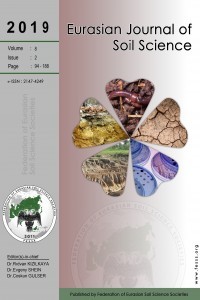
Eurasian Journal of Soil Science
Yazarlar: Simon Djakba BASGA, Jean Pierre TEMGA, Désiré TSOZUÉ, Nicodème DANBÉ, Jean Pierre NGUETNKAM
Konular:Fen
DOI:10.18393/ejss.460841
Anahtar Kelimeler:Topomorphic vertisols,Clay,Smectites,Dry season sorghum,North Cameroon
Özet: In the present study, two topomorphic vertisols profiles used for sorghum production were described and characterized. After macroscopic characterization, physicochemical, mineralogical and geochemical analyses were made. Physicochemical analyses were made by standard methods while mineralogy was determined on clay fraction (˂2µm) by X-ray diffraction coupled to Fourier transform infrared spectroscopy. Geochemical analysis was determined on 180µm fraction by inductively coupled plasma- Atomic Emission Spectroscopy (ICP-AES) and mass spectrometry (ICP-MS). Results revealed that studied vertisols were average deep, less differentiated with desiccations cracks and gilgai micro relief. The angular blocky structure and clayey texture were observed. They were alkaline (7.3 ≤ pHwater ≤ 8.4) and recorded a low to moderate organic matter and nitrogen contents. Cation exchange capacity was high reaching 52.24 meq 100g-1 and exchangeable cations were moderates with Ca2+ (3.69- 29.6 meq 100g-1) the most represented cation. Vertisols were made of smectites associated to kaolinite and a lesser content of quartz. Illites and calcite were also identified in some horizons. On the geochemical point of view, Si02 (55.87- 83.64%), Al2O3 (6.08-20.25%), Fe2O3 (2.09-6.39%) and K2O (1.43-2.24 %) were the dominant oxides. Traces elements were represented essentially by Ba (518-1202 mg kg-1), Zr (334-685 mg kg-1) and Sr (71-190 mg kg-1). The overall features are suitable to dry season sorghum production. The amount of smectites seemed to be an important factor affecting their water holding capacity on which dry season sorghum production depends. Improved cropping systems have to be developed to sustain productivity in vertisols with low smectites and where annual rainfall is lesser.